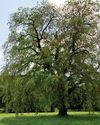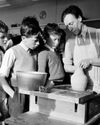
IN May, a book was published titled Broken: Mending and repair in a throw away world. It tackles the reality that we live in what the author, Katie Treggiden, describes as a ‘single-use society’, where fashion is fast, disposability is the norm and it’s easier to replace than to repair. She traces the linear take-make-waste model that has dominated Western economies back to the Industrial Revolution and champions the need to transform it into something more circular for the good of our planet, and ourselves.
Mending—or the desire to have things mended—is both generational and attitudinal. For some, it’s instinctive. My mother-in-law, born in 1938, has never needed to be lectured about the importance of looking after resources (we’ve come to blows about using margarine to make white sauce; I pointed out that butter rationing ended in 1954). To the distraction of the rest of the family, she has steadfastly held onto the belief that all items can and should be mended and for many years amassed a collection of redundant toasters, kettles and vacuum cleaners. A Belling warming cabinet, which hasn’t warmed a plate since at least 2005, has been repurposed as a storage unit. The problem—and this is one experienced by many—is a blend of not being able to distinguish between what is worth mending (or would be hazardous should an electric current ever pass through it again) and not knowing where the skills lie to have pieces fixed, if they exist at all.
Bu hikaye Country Life UK dergisinin June 14, 2023 sayısından alınmıştır.
Start your 7-day Magzter GOLD free trial to access thousands of curated premium stories, and 9,000+ magazines and newspapers.
Already a subscriber ? Giriş Yap
Bu hikaye Country Life UK dergisinin June 14, 2023 sayısından alınmıştır.
Start your 7-day Magzter GOLD free trial to access thousands of curated premium stories, and 9,000+ magazines and newspapers.
Already a subscriber? Giriş Yap

A leap in the dark
The primal play of light and shadow, whether in Leonardo's ever-so-subtle sfumato or Caravaggio's dramatic contrasts, has shaped Western art, as Michael Hall reveals

Beauty and the blimp
Inflammable airships may be gone, but a new hybrid aircraft, capable of delivering eco-friendly aviation, is set to take to the skies with a bang, finds Charles Harris

Three wishes for food and farming
Royal hedge planting, the terrible toll on Ukrainian farming and a maiden speech

Seeing the wood for the trees
Scotland's much-evolved forestry industry has become a focus for clever investors

Let's fall in love
Birds do it, bees do it, even educated fleas do it. Laura Parker finds that, when it comes to creatures mating for life, persistence, patience and a little dad dancing are key to success

Back from the dead
THREE Wentworth elm saplings have been planted in the grounds of the Palace of Holyroodhouse, Edinburgh, and on the Highgrove estate in Gloucestershire-29 years after what was thought to be the lastknown Wentworth elm died.

A man among men
What makes a master? Beloved of the commercial art world, handled warily by art historians, the word has long been opaque. Michael Prodger investigates its many meanings-and discovers that being male confers an unfair advantage

Unearth one of life's luxuries
Black diamonds are a girl's best friend this Valentine's Day, with Périgord truffle-based skincare from TRUFFE

Adventure awaits
Spend an unforgettable family holiday on the Benmore Estate and experience some of Scotland's finest wildlife and sporting activities

Let the art rule the head
Despite being a world leader in everything from jewellery to fashion and music, the UK is failing to nurture creativity at school and in regional centres. Tristram Hunt, director of the V&A Museum, calls for an urgent review